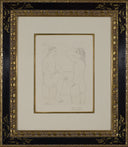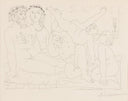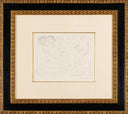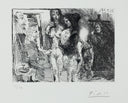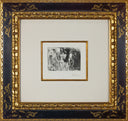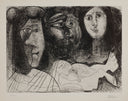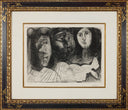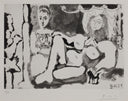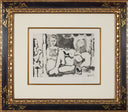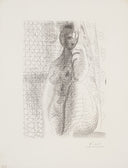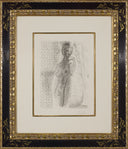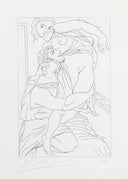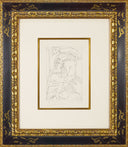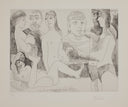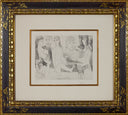Two Nudes (Vollard Suite, B.209), 1934
Details
Year: 1934
Edition: 303
Sheet size: 17.5 x 13.5"
Image size: 11 x 7.87"
Framed size: 25.5 x 22"
Signature: signed 'Picasso' lower right
About the Work
"Two Nudes (B.209)" is an etching created by Pablo Picasso for his 'Vollard Suite' in 1934. From the edition of 303, the artwork is hand-signed 'Picasso' lower right. The image size is 11 x 7.87" and the artwork is framed in a custom Spanish-style, closed-corner, black and gold frame. The artwork ships framed and is accompanied by a certificate of authenticity.
The 'Vollard Suite' takes its name from Ambroise Vollard, the foremost Parisian art dealer of the early twentieth century. From 1893 to 1914, his gallery at 6 Rue Laffitte served as the epicenter of the Paris avant-garde, a gathering space for radical artists and pioneering collectors. Vollard’s shift into print publication in the early twentieth century proved visionary: his collaborations with modern masters are now widely regarded as some of the greatest cultural achievements of the era.
The 'Vollard Suite' etchings, reflecting the neoclassical component of Picasso’s work, span the years between 1930 and 1936 with themes that include the “Battle of Love,” “The Sculptor’s Studio,” “Rembrandt,” “The Minotaur,” and “The Blind Minotaur,” plus, 27 non-grouped sheets and 3 portraits of Vollard. They are also a reflection of Picasso’s crucial and developing relationship with the highly skilled master printer, Roger Lacouriere. The technical complexity of the prints increased in the later years, most notably with the inclusion of the sugar-lift aquatint technique which Picasso learned from Lacouriere, and which allowed for subtle tonal variations, and a painterly effect.
Created in 1934, "Two Nudes" stands as one of the 27 non-grouped etchings in the Vollard Suite, yet it is far from peripheral. This print crystallizes the emotional and physical dynamism that defines much of Picasso’s work during this period.
Unlike the more languid or mythological images found elsewhere in the suite, "Two Nudes" captures a moment of taut, almost theatrical, intimacy between two women. The seated figure dominates the foreground, posed in a semi-classical fashion with one leg crossed over the other. Her posture is composed but not passive, her hands rest deliberately, one across her knee and the other in her lap, suggesting control or contemplation. The angularity of her limbs contrasts with the more fluid, vertical energy of the standing figure.
The second nude stands just in front of the seated woman, arms raised, her hands tangled in her hair. This upward gesture not only reveals her form in full but also introduces a moment of suspended movement, a visual crescendo that draws the eye vertically and emphasizes her physicality. Her pose, more expressive and unconstrained, introduces a sensual counterpoint to the grounded serenity of the seated figure.
The absence of setting or background in the print distills the scene down to pure line and form. Picasso’s use of etching here is elegant and economical, contours vary in pressure and rhythm, giving the bodies a sculptural weight despite their flatness on the page.
"Two Nudes" is a study in duality: of postures, emotional registers, and artistic intent. It stands as a quiet masterwork within the 'Vollard Suite', offering a moment of raw visual dialogue between two female forms. The relationship between them, ambiguous yet charged, reinforces the suite’s broader themes of creation, contemplation, and erotic complexity. It is a testament to Picasso’s ability to distill layered emotional narratives into a single, concise image, and a vital contribution to one of the most significant print cycles of the twentieth century
About the Artist
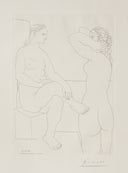
Two Nudes (Vollard Suite, B.209), 1934
MORE FROM THIS ARTIST
Start your collection with guidance you can trust
For nearly 50 years, we’ve helped new collectors find artwork they love and understand the stories behind each piece. Our gallery consultants offer personalized guidance, whether you’re exploring originals, limited editions, or discovering an artist for the first time. Visit your nearest gallery to start collecting with confidence.


Frequently Asked Questions
Your artwork comes with a Certificate of Authenticity (or Letter of Authenticity), professional packaging, and insured delivery.
We ship fully insured, using trusted carriers. Each piece is professionally packed to ensure safe arrival. Shipping times vary based on the location of the art, its destination, and whether or not it is framed (ready to ship) at the time of your purchase.
All our works come beautifully framed. Some print multiples may have framing options if we have unframed editions available in our warehouse. Our in-house framing provides high-quality moulding, acid-free materials and either UV plexiglass or framer’s grade acrylic. High value works may be framed in custom, closed-corner frames, and are often framed in Optium museum glass for enhanced clarity.
No, Martin Lawrence Galleries does not provide appraisal services. To ensure that appraisals are fully independent and unbiased, it is best practice for them to be carried out by certified appraisers who have not had prior involvement with the sale or handling of the artwork. For that reason, we do not appraise artworks that we handle, and instead recommend that collectors seek an independent, certified appraiser.
No, we own the vast majority of our inventory and do not seek out consignments from Sellers.
Yes, if you purchase from a local gallery, your consultant will be happy to assist you with hanging the artwork in your home.
Martin Lawrence Galleries has seven galleries across the country where you may be able to see the exact piece you are interested in. Print and sculpture multiples are more likely to be in several places for possible viewings whereas unique artworks will be constrained to one location. We are happy to facilitate your visit to one of our galleries if that is convenient for you. We can also take videos and extensive photos if a visit is not possible. Please contact us at martinlawrencegalleries.com.
We have over 50 years of experience, seven gallery locations across the United States, and a track record of connecting collectors with the right artwork.
No. Our consultants are here to guide you through the process, answer your questions, and make buying art simple and rewarding.
We encourage you to buy what you love. Our consultants will help you find the right piece that fits your taste and collection.
Please visit our page on specific instructions on how to take care of your artworks. Care Instructions
We stand by our artwork. Please review our detailed return policy here.


